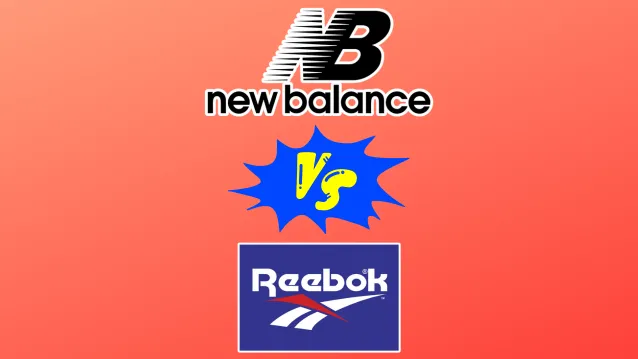As an avid sneakerhead and athlete, I’m always on the hunt for the perfect pair of shoes. New Balance and Reebok are two powerhouse athletic brands, but they each have their own strengths.
In this article, I’ll compare the key factors like comfort, performance, style, and price point to help you decide which brand might be best for your needs. Both have a longstanding history in the footwear world, so let’s take a closer look at how they stack up!
Comparison Table
| Category | New Balance | Reebok |
|---|---|---|
| Founded In | 1906 | 1895 |
| Comfort and Fit | Offers a wide range of sizes and widths to accommodate different foot shapes. Known for comfort and support. | Comfortable with technologies like DMX cushioning. Offer shoes for different arch types. |
| Color Options | Wide range of color options | Variety of color options |
| Durability | Well-made and durable | Known for durability |
| Performance | Variety of technologies to improve performance for runners and athletes | Use technologies like DMX and Floatride for performance |
| Design and Style | Classic and stylish designs across a range of shoes | Contemporary, stylish designs |
| Popularity | Very popular, one of the largest athletic shoe brands | Popular athletic brand, known for training shoes |
| Best Selling Model | 880v11 | Reebok Nano |
New Balance Overview
Founded in 1906 by William J. Riley, New Balance began by making arch supports and prescription shoes for people with foot issues.
Based in Boston, the brand gained popularity for technical innovations like ripple soles and heel counters to stabilize and customize fit.
While New Balance makes athletic shoes across sports, they remain deeply rooted in running due to their origins in correcting overpronated feet.
Core neutral shoes like the 880 use injected EVA midsoles for soft landings and Ortholite insoles for support.
Iconic models like the 990 integrate dual-density midsoles and Abzorb foams to combine cushioning with compression resistance for smooth transitions.
New Balance leans into retros styles while also incorporating new 3D printed midsoles and engineered mesh uppers. With masterful attention to fit adjustments for all foot shapes and biomechanical needs, New Balance delivers versatile performance and classic appeal across running categories.
Reebok Overview
With a long legacy spanning over 100 years, Reebok remains one of the most established and iconic athletic brands worldwide.
Founded in England in 1895 by Joseph William Foster, Reebok’s history dates back to innovations like the first spiked running shoe.

Now headquartered in Boston, Reebok engineers shoes for performance, comfort, and style across training, running, and everyday wear.
Reebok incorporates proprietary technologies like DMX Shear cushioning and Floatride Energy foam to provide both cushioning and responsiveness.
With pressure mapping and Memory Tech Massage footbeds, many Reebok shoes contour precisely to the shape of the foot for a truly customized fit and feel.
The brand also remains committed to sustainability, using recycled materials in over 75% of product lines. From vintage styles like the Freestyle to fitness must-haves like the Nano, Reebok’s timeless sporty designs have universal appeal.
With both substance and style, Reebok continues pushing boundaries while staying true to its classic roots.
Major Differences Between these Brands
Comfort and Fit
While both brands aim for comfort, New Balance leads in this category. With wide size ranges, width options, and supportive technologies, New Balance explicitly focuses on accommodating all foot shapes and types.
Reebok does aim for comfort but has fewer specialized fit options. For those needing a truly customized, comfortable fit, New Balance is likely the better choice.
Durability and Performance
Both New Balance and Reebok are known for their durable shoes that can handle athletic activities. New Balance uses abrasion-resistant materials and Reebok utilizes durable leathers and synthetic overlays.
Both also integrate technologies like Fresh Foam and DMX to improve performance. For the average user, durability and performance are likely comparable between the two brands. Serious athletes may notice small performance differences depending on their sport.
Price
New Balance shoes tend to range from $60-$200 based on the model. Reebok’s prices also span from $50-$200 depending on the features and technologies used. Both offer shoes at several price points.
New Balance does carry some higher-end specialty running shoes over $200 while Reebok generally caps at $200. Overall, pricing is similar, with New Balance having some pricier high-performance options.
Design and Style
Both brands offer stylish, attractive shoe designs, but their aesthetics differ. New Balance leans classic, with clean leather and suede options in a range of neutral and bold colors.
Their designs are timeless versus trendy. Reebok has sleek, modern designs, like their DMX series, along with their classic leather lines. Those wanting a contemporary, fashion-forward look may prefer Reebok’s styles.
Popularity
As one of the largest global athletic brands, New Balance edges out Reebok in popularity and market share today. However, Reebok remains better-known than many competing brands. Reebok likely loses some Millennial and Gen Z sales to trendier or niche brands. But for broad appeal across generations, both remain strong legacy brands.
Target Market
New Balance markets to a wide demographic seeking comfort and quality. They have an edge with serious runners and older customers wanting proper support. Reebok broadly targets the fitness crowd and young urban fashion market. Reebok likely appeals more to the style-focused athletic shoe buyer versus New Balance’s function-focused market.
Performance Comparison
For Nurses
For nurses constantly on their feet, comfort is key. New Balance offers features like pillowy Fresh Foam cushioning and slip-resistant outsoles ideal for the demands of nursing. The wide range of sizing and support make New Balance a great choice for a nursing shoe.
For Walking
Both brands cater well to walkers needing a lightweight, flexible, cushioned shoe. For all-day wear, New Balance walking shoes may edge out Reebok with features like rollbars for stability and Abzorb cushioning under the balls of the feet. For casual short walks, either brand could work well.
For Running
Serious runners and marathoners may lean New Balance for shoes like the FuelCell Rebel with cutting-edge performance technologies. But both brands offer great options for joggers. Reebok Floatride Energy foam and DMX cushioning provides a responsive, well-cushioned ride too. So for most runners, it’s a toss up.
For Flat Feet
With stability features like medial posts and options for custom orthotics, New Balance tends to better accommodate flat feet and overpronation. It offers motion-control shoes with maximum stability. While Reebok has some stability options, they don’t offer the same specialized range as New Balance.
For Back Pain
With arch support and ample cushioning from their Fresh Foam or Abzorb foam, New Balance shoes can help minimize back pain. They specifically have walking shoes designed to reduce strain on the back and hips. Reebok can also provide a cushioned ride to absorb impact, making both solid brands for back pain issues.
For Standing All Day
Cushioning and comfort is paramount for standing all day. Both brands work, but New Balance has the edge with features like shock absorption in the heel and forefoot cushioning to alleviate pressure. Reebok uses DMX and Floatride foam to cushion as well, so either brand could work for extended standing.
For High Arches
Those with high arches require strong arch support from their shoes. New Balance explicitly segments their shoes not just by pronation levels, but also by arch height – low, medium and high. Reebok shoes accommodate arches, but don’t have the specialized range New Balance offers. For high arches, New Balance is likely the better option.
For Hiking
With rugged traction and stability control, New Balance hiking shoes and trail runners are well suited for serious hiking. Reebok offers some trail shoes but their main focus in on training versus hiking. For hikers tackling tough terrain, New Balance has the technology and features best suited for the trails.
For Plantar Fasciitis
Plantar fasciitis requires arch support, shock absorption and durable cushioning. New Balance’s stability shoes have the features and cushy Abzorb foam ideal for this condition. While Reebok can work, their lack of specialized stability shoes and cushy insoles put New Balance ahead for addressing plantar fasciitis.
Final Verdict
In the battle between these two athletic titans, New Balance just barely edges out Reebok for me. With unparalleled fit options, shock absorption and support, New Balance takes the win for comfort and foot health – critical for my needs and those with particular foot conditions.
However, Reebok remains a solid choice, especially if you prioritize modern style. And with both brands offering quality performance and durability, you truly can’t go wrong with either for your next pair of sneakers. Whichever you choose, your feet are sure to stay happy mile after mile.


